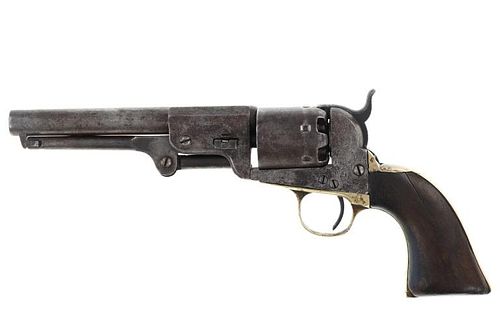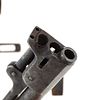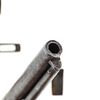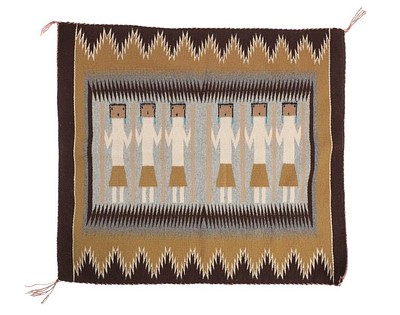Confederate J.H. Dance & Brothers .36 Revolver
About Auction
Nov 13, 2023 - Nov 17, 2023
Auction Timed Online Only, begins ending November 17th, at 1 p.m. Mountain Time. Preview online. Shipping available for all items. Email tucker@naabid.com or call 800-686-4216 for more info. NaaBid.com North American Auction Company tucker@naabid.com
- Lot Description
This is an original, authentic Civil War Confederate Texas J.H. Dance and Brothers .36 caliber Navy Revolver with an extremely rare 6 inch long barrel. The revolver exhibits a 6-inch long round barrel with back octagonal section having the correct 7-groove rifling with slow gain clockwise, 6-shot cylinder that measures 1 21/32-inches in length, is chambered in .36 caliber, is famously void of recoil shields (a noted feature of Dance revolvers) and has a total length of about 11 ½-inches. This is the scarce Dance Navy variant with a 6-inch barrel which is one of only a few known examples to exist. James Henry Dance and his brother established J. H. Dance in 1858, manufacturing gristmills and cotton gins. During the Civil War, they began producing firearms for the Confederacy receiving a contract for 50 revolvers per week. Over the next few years, 1862-1863, the company produced 300-400 revolvers. This example has all serial numbers matching as it is marked with a “79” on the brass butt, brass trigger guard behind the screw, on the frame, and on the barrel to frame connection as well as on the cylinder. The top is engraved CSA, an unusual attribute, but has been examined professionally and is both of the correct 1800s age and is believed to be original to the gun. The revolver has a hammer notch rear sight and is cut in the barrel for a silver blade front site which is absent. Has a brass back strap and trigger guard with one piece walnut grips. Frame screws have rounded heads, typical of other .36 caliber Navy Dance revolvers. Mechanically the revolver has a roller on the hammer, a noted authentic Dance feature, clicks back three times which rotates the cylinder, pulling the trigger releases the hammer, appearing to function correctly. The revolver has the Dance loading aperture or capping release groove in the correct spot which has been filled in and pounded flat having a punch engraved or marked circle design. J.H. Dance & Brothers Navy revolvers were produced in Texas by hand and issued for Confederate use in Texas Cavalry units, documented to have been issued to at least the 35th (Brown’s) Texas Cavalry and Sutton’s Cavalry (Graham Rangers), who used these revolvers to defend the Texas frontier and the Gulf Coast. Things to note about J.H. Dance & Brothers revolvers as compared to this authentic original example from published works: From “Dance & Brothers: Texas Gunmakers of the Confederacy” by Gary Wiggins 1986: Page 47 mentions, “The grips of Dance revolvers exhibit shrinkage… Due to the pressures of the war, Dance was unable to age the wood and the grips cured “in the holster.” This phenomenon is common to the Confederate made handguns.” Also shown on our grips. On page 61 is Dance Revolver Serial Number 83 which shows a .36 caliber Navy revolver “…with a part round and part octagonal barrel slightly over 6” long. The cylinder is 1 21/32” long and the total length of the sidearm is 11 1/2”. This is nearly the identical revolver as our example, serial number 79, which proves the existence of a .36 caliber Dance Navy with 6 inch barrel. The SN 83 example shows a gap at the outside of the barrel wedge, the distance from the percussion cap cutout on the cylinder to the barrel catch and brass trigger guard that are all exactly the same as the Dance SN 79 in this lot. On page 66, shows Dance Serial Number 111 a .36 caliber Navy model noted as, “This Dance also has other peculiarities not commonly seen in Dance revolvers. It appears to be less complete the standard Dance revolvers: this specimen does not have a wedge screw, loading aperture or capping release groove.” Meaning the small cutout found on the left side of the frame, at the top has been filled in, the exact same as the gun offered in this lot. Pages 79-81, show Dance Serial Number 172 which has a circle punch engraving found all over the gun, one of the only examples known to have this. Interestingly, but possibly not applicable, the revolver in this example shows the loading aperture of capping release groove filled in by a blacksmith and pounded flat using a punch dot circle finish. Pages 110-111 show a Dance Revolver with Serial Number JB. This and several other Dance revolvers did not have serial numbers but rather letter or other markings with this example only being marked in a few spots with JB and not the many others spots, the same as our example. Pages 48 and 49, show Dance Revolver Serial Number 50 a .36 caliber Navy model. This revolver shows many exact features as our example such as the same barrel wedge with cutout and insert, rounded screw heads, exact brass trigger guard, and same distance from percussion cutout on cylinder to barrel catch. From “The Gun Collector No. 29 August 1949” article “The Dubious Dance”: On Page 339 the author talks by Mr. Pickell’s Dance and the argument of altered Colt 1851 Navy revolvers, “Let us consider the problems involved in altering an 1851 Navy to a Dance. First we must determine where the Dance has more metal than its prototype, as it is more difficult to add metal than to cut it away. The first instance is in the cylinder slots which are .16 inches long on the Dance as against .23 inches on the Colt (Metropolitan .27)… the pawls on the Colt are cut in scallop shape… and it would require a delicate welding and machining job to alter these to the straight teeth found on the Dance.” Our revolver, SN 79, has cylinder slots with a measurement of .16 inches long, the correct authentic size documented, and the cylinder teeth are slanted / straight and not scooped or scalloped. Page 340 shows Dance serial number 135 with a curved top to the five, documenting the use of a curved font such as our “79” (with the same “9” in 119 shown as well). On page 341, “…the Dance has a regular pitch of 1 turn in 28 inches (referring to the 7 cut rifling of the barrel). Our example has the correct seven cut rifling in the barrel with the same slow gain of twist. From “Confederate Longarms and Pistols” by Richard Taylor Hill and William Edward Anthony 1978: On page 278 a Dance serial number 83 in rare .36 caliber Navy with 6 1/8”, total length 11 ½”, 1 21/32” long 6-shot cylinder as well as the larger distance from cylinder slot to percussion cap cutout, and gap next to the barrel wedge. Our example, SN 79, shows a 6 inch long barrel, total length of about 11 ½”, exact same 6-shot cylinder with a length of 1 21/32”, with larger distance between cylinder slot and percussion cap cutout, small gap on the inside of the barrel wedge as well as the exact same brass trigger guard. The gun offered in this lot SN 79 is nearly completely identical to the documented SN 83 published in the above-mentioned book. On the next page, 279, shows Dance .44 revolver SN 95 with the butte serial number having the exact same “9” as our example. From “Confederate Handguns: Concerning the Guns the Men Who Made Them and the Times of Their Use” by William A. Albaugh III, Hugh Benet Jr. and Edward N. Simmons 1963. On page 158, “The third variety is .36 caliber and is extremely rare… specimen found has been seen with a barrel only 6 inches long”, the same as our own SN 79. Also page 159 shows a .36 Navy Dance with rounded screw heads and a cut into the barrel wedge, the same as our example. Included in this lot is the following: Dance Navy .36 Revolver SN 79, a signed first edition of Texas Gunmakers of the Confederacy” by Gary Wiggins 1986; the book “Confederate Longarms and Pistols” by Richard Taylor Hill and William Edward Anthony first edition 1978 signed by both authors; the book / publication “The Gun Collector No. 29 August 1949” article “The Dubious Dance”; the book / publication ”The Gun Collector No. 22 May 1948” by Paul C. Janke; the book / publication “The Gun Collector No. 24 September 1948; and the book “Confederate Handguns: Concerning the Guns the Men Who Made Them and the Times of Their Use” by William A. Albaugh III, Hugh Benet Jr. and Edward N. Simmons 1963. The revolver exhibits original condition. The flat frame without recoil shields has the correct appearance for its manufacture. There is some coloring remaining on the gun, mostly on the cylinder, the grips are slightly shrunk and have a small crack on the left side, a noted feature in authentic Dance revolvers. The brass back strap is slightly loose. The gun was looked over, under a microscope and the markings and conditions are correct for its1862-1863 age. Truly a rare piece, and considered by many to be the “Holy Grail” of Confederate firearms. Within the known Dance Revolvers, only one other Dance .36 caliber Navy currently exist with a 6-inch barrel, making this one of only two known, a true rarity. Antique NO FFL.*
- Shipping Info
-
After you have succeessfully completed your purchase, including payment of your item, the shipping process will begin. Our company has partnered with a few local third party shipping vendors. Shipping will be handled between these third party business and the buyer. Auction company is not responsible for shipment or any duties there-in unless stated below. Firearms will be shipped by our company. Once you invoice has been paid for contact Mark at 800-686-4216 ext. 3 for shipping infomation on firearms. After your invoice has been paid one of the below third party shippers will pickup your items. Once these companies have created a shipping quote for you they will contract you using the contact information you have provided on your auction registration. Make sure to include the shipping address and correct contact information for a success shipping experience. For questions on shipping please contract the companies below or JoEllen at 800-686-4216 ext. 1 For shipping quotes please contract the companies below: "The UPS Store” #2420 1106 W Park St, Livingston, MT 59047 Hours: Monday - Friday, 8:30am - 6:00pm Saturday, 10:00am - 3:00pm Sunday, CLOSED Phone: 406-222-4971 Fax: 406-222-9257 Email: store2420@theupsstore.com Postal Annex 280 West Kagy Boulevard D, Bozeman, MT 59715 Hours: Monday - Friday, 8:00am - 6:00pm Saturday, 10:00am - 3:00pm Sunday, CLOSED Phone: 406-219-2210 Fax: 406-219-2209 Email: pa14012@postalannex.com
-
- Buyer's Premium



 EUR
EUR CAD
CAD AUD
AUD GBP
GBP MXN
MXN HKD
HKD CNY
CNY MYR
MYR SEK
SEK SGD
SGD CHF
CHF THB
THB




































